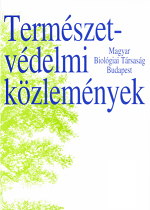Természetvédelmi célú léknyitások hatása egy cseres-tölgyes újulatára
Absztrakt
A természetvédelmi erdőkezelések célja a vágásos gazdálkodás által homogenizált erdők szerkezetének és fafaj-összetételének változatosabbá tétele, és ezáltal a biodiverzitás fokozása. Kutatásunkban természetvédelmi célú léknyitások hatásait vizsgáltuk kocsánytalan tölgy (Quercus petraea), mezei juhar (Acer campestre) és házi berkenye (Sorbus domestica) csemetéinek növekedésére, kezeletlen zárterdei kontrollhoz viszonyítva, a fény- és mikroklimatikus viszonyok tükrében. Eredményeink alapján lékek nyitásával úgy növelhető meg az újulati szintre jutó fény mennyisége, hogy közben megőrizhető a zárterdei hűvös-párás mikroklíma. A léknyitás segíti minden vizsgált fafaj csemetéinek növekedését, így megindítható a homogén, zárt állományok szerkezeti heterogenizációja. A megnövekedett fényből az elegyfafajok csemetéi jobban profitáltak, mint a tölgy, a léknyitásokkal tehát a faállomány jövőbeli elegyessége is fokozható.
Hivatkozások
Abd Latif, Z., Blackburn, G. A. (2010): The effects of gap size on some microclimate variables during late summer and autumn in a temperate broadleaved deciduous forest. International Journal of Biometeorology 54: 119–129. https://doi.org/10.1007/s00484-009-0260-1
Allen, R. G., Pereira, L., Raes, D. Smith, M. (1998): FAO irrigation and drainage paper No. 56. FAO, Rome: Food and Agriculture Organization of the United Nations.
Annighöfer, P., Beckschäfer, P., Vor, T., Ammer, C. (2015): Regeneration patterns of European oak species (Quercus petraea (Matt.) Liebl., Quercus robur L.) in dependence of environment and neighborhood. PLOS ONE 10(8): e0134935. https://doi.org/10.1371/journal.pone.0134935
Ádám, R., Ódor, P., Bidló, A., Somay, L., Bölöni, J. (2018): The effect of light, soil pH and stand heterogeneity on understory species composition of dry oak forests in the North Hungarian Mountains. Community Ecology 19: 259–271. https://doi.org/10.1556/168.2018.19.3.7
Bauhus, J., Puettmann, K., Messier, C. (2009): Silviculture for old-growth attributes. Forest Ecology and Management 258: 525–537. https://doi.org/10.1016/j.foreco.2009.01.053
Bernes, C., Jonsson, B. G., Junninen, K., Lõhmus, A., Macdonald, E., Müller, J., Sandström, J. (2015): What is the impact of active management on biodiversity in boreal and temperate forests set aside for conservation or restoration? A systematic map. Environmental Evidence 4: 25. https://doi.org/10.1186/s13750-015-0050-7
Bobiec, A. (2007): The influence of gaps on tree regeneration: A case study of the mixed lime-hornbeam (Tilio-Carpinetum Tracz. 1962) communities in the Białowieża Primeval Forest. Polish Journal of Ecology 55: 441–455.
Bobiec, A., Jaszcz, E., Wojtunik, K. (2011): Oak (Quercus robur L.) regeneration as a response to natural dynamics of stands in European hemiboreal zone. European Journal of Forest Research 130: 785–797. https://doi.org/10.1007/s10342-010-0471-3
Boros, G., Kovács, B., Ódor, P. (2019): Green tree retention enhances negative short-term effects of clear-cutting on enchytraeid assemblages in a temperate forest. Applied Soil Ecology 136: 106–115. https://doi.org/10.1016/j.apsoil.2018.12.018
Bölöni, J., Molnár, Zs., Kun, A. (szerk., 2011): Magyarország élőhelyei: Vegetációtípusok leírása és határozója, ÁNÉR 2011. MTA Ökológiai és Botanikai Kutatóintézete, Vácrátót, 439 p.
Bölöni, J., Aszalós, R., Frank, T., Ódor, P. (2021): Forest type matters: Global review about the structure of oak dominated old-growth temperate forests. Forest Ecology and Management 500: 119629. https://doi.org/10.1016/j.foreco.2021.119629
Collet, C., Lanter, O., Pardos, M. (2001): Effects of canopy opening on height and diameter growth in naturally regenerated beech seedlings. Annal of Forest Science 58: 127–134. https://doi.org/10.1051/forest:2001112
Csépányi, P., Ódor, P., Tinya, F. (2021): A kocsánytalan tölgy újulat fejlődése az örökerdő változatos fényviszonyai között. In: Tinya, F. (szerk.): 12. Magyar Ökológus Kongresszus – Előadások és poszterek összefoglalói, p. 151.
de Groot, M., Eler, K., Flajsman, K., Grebenc, T., Marinsek, A., Kutnar, L. (2016): Differential short-term response of functional groups to a change in forest management in a temperate forest. Forest Ecology and Management 376: 256–264. https://doi.org/10.1016/j.foreco.2016.06.025
Demeter, L., Molnár, Á. P., Öllerer, K., Csóka, Gy., Kis, A., Vadász, Cs., Horváth, F., Molnár, Zs. (2021): Rethinking the natural regeneration failure of pedunculate oak: The pathogen mildew hypothesis. Biological Conservation 253: 108928. https://doi.org/10.1016/j.biocon.2020.108928
Denslow, J. S., Ellison, A. M., Sanford, R. E. (1998): Treefall gap size effects on above‐ and below‐ground processes in a tropical wet forest. Journal of Ecology 86: 597–609. https://doi.org/10.1046/j.1365-2745.1998.00295.x
Diaci, J., Györek, N., Gliha, J., Nagel, T. A. (2008): Response of Quercus robur L. seedlings to north-south asymmetry of light within gaps in floodplain forests of Slovenia. Annals of Forest Science 65: 105. https://doi.org/10.1051/forest:2007077
Doerfler, I., Müller, J., Gossner, M. M., Hofner, B., Weisser, W. W. (2017): Success of a deadwood enrichment strategy in production forests depends on stand type and management intensity. Forest Ecology and Management 400: 607–620. https://doi.org/10.1016/j.foreco.2017.06.013
Dovčiak, M., Brown, J. (2014): Secondary edge effects in regenerating forest landscapes: vegetation and microclimate patterns and their implications for management and conservation. New Forests 45: 733–744. https://doi.org/10.1007/s11056-014-9419-7
Dövényi, Z. 2010. Magyarország kistájainak katasztere. MTA Földrajztudományi Kutatóintézet, Budapest.
Duguid, M. C., Ashton, M. S. (2013): A meta-analysis of the effect of forest management for timber on understory plant species diversity in temperate forests. Forest Ecology and Management 303: 81–90. https://doi.org/10.1016/j.foreco.2013.04.009
Duursma, R. (2015): Plantecophys – An R Package for Analysing and Modelling Leaf Gas Exchange Data. PLOS ONE 10: e0143346. https://doi.org/10.1371/journal.pone.0143346
EEA (2016): European forest ecosystems. State and trends. EEA Report. European Environmental Agency, Luxemburg.
Elek, Z., Kovács, B., Aszalós, R., Boros, G., Samu, F., Tinya, F., Ódor, P. (2018). Taxon-specific responses to different forestry treatments in a temperate forest. Scientific Reports 8: 16990. https://doi.org/10.1038/s41598-018-35159-z
Frank, T., Szmorad, F. (szerk., 2014). Védett erdők természetességi állapotának fenntartása és fejlesztése. Rosalia kézikönyvek 2. Duna–Ipoly Nemzeti Park Igazgatóság, Budapest, 160 p.
Geiger, R., Aron, R. H., Todhunter, P. (1995): The Climate Near the Ground. Vieweg+Teubner Verlag, Wiesbaden.
Gitau, M. G. (2023): Regeneration success of sessile oak under different gap cuttings in an oak-hornbeam forest. MSc Thesis, Eötvös Loránd University, Faculty of Science, Center for Environmental Science, Budapest, 52 p. https://piliskiserlet.ecolres.hu/node/147
Götmark, F. (2013): Habitat management alternatives for conservation forests in the temperate zone: Review, synthesis, and implications. Forest Ecology and Management, 306: 292–307. https://doi.org/10.1016/j.foreco.2013.06.014
Guyot, V., Castagneyrol, B., Vialatte, A., Deconchat, M., Jactel, H. (2016): Tree diversity reduces pest damage in mature forests across Europe. Biology Letters 12: 20151037. https://doi.org/10.1098/rsbl.2015.1037
Horváth, Cs. V., Kovács, B., Tinya, F., Schadeck Locatelli, J., Németh, Cs., Crecco, L., Illés, G., Csépányi, P., Ódor, P. (2023): A matter of size and shape: Microclimatic changes induced by experimental gap openings in a sessile oak–hornbeam forest. Science of the Total Environment 873: 162302. https://doi.org/10.1016/j.scitotenv.2023.162302
IPBES (2018): The IPBES Regional Assessment Report on Biodiversity and Ecosystem Services for Europe and Central Asia. p 978-973-947851-947808-947859 in M. Rounsevell, M. Fischer, A. Torre-Marin Rando, and A. Mader, editors. Secretariat of the Intergovernmental Science-Policy Platform on Biodiversity and Ecosystem Services, Bonn, Germany.
Jónsdóttir, I. S., Watson, M. A. (1997): Extensive physiological integration: an adaptive trait in resource-poor environments? In: de Kroon, H., van Groenendael, J. (eds.): The Ecology and Evolution of Clonal Plants. Backhuys, Leiden. https://eurekamag.com/research/031/395/031395435.php
Keeton, W. S. (2006): Managing for late-successional/old-growth characteristics in northern hardwood-conifer forests. Forest Ecology and Management 235: 129–142. https://doi.org/10.1016/j.foreco.2006.08.005
Király, G. (2009): Új magyar füvészkönyv. Magyarország hajtásos növényei. Határozókulcsok. Aggteleki Nemzeti Park Igazgatóság, Jósvafő, 616 p.
Kollár, T. (2017): Light conditions, soil moisture, and vegetation cover in artificial forest gaps in western Hungary. Acta Silvatica Lignaria Hungarica 13: 25–40. https://doi.org/10.1515/aslh-2017-0002
Kovács B., Kelemen K., Ruff J., Standovár T. (2013): Üzemi léptékben alkalmazott átalakító üzemmód lékes felújításának tapasztalatai a királyréti erdészet területén. Erdészettudományi Közlemények 3: 55–70. http://www.erdtudkoz.hu/cikkek/2013-004.pdf
Kovács, B., Tinya, F., Németh, Cs., Ódor, P. (2020): Unfolding the effects of different forestry treatments on microclimate: results of a 4-year experiment. Ecological Applications 30: e02043. https://doi.org/10.1002/eap.2043
Larsen, D. R., Johnson, P. S., (1998): Linking the ecology of natural oak regeneration to silviculture. Forest Ecology and Management 106: 1–7. https://doi.org/10.1016/S0378-1127(97)00233-8
Lemmon, P. E. (1956): A spherical densiometer for estimating forest overstory density. Forest Science 2: 314–319.
Lendzion, J., Leuschner, C. (2008): Growth of European beech (Fagus sylvatica L.) saplings is limited by elevated atmospheric vapour pressure deficits. Forest Ecology and Management 256: 648–655. https://doi.org/10.1016/j.foreco.2008.05.008.
Ligot, G., Balandier, P., Fayolle, A., Lejeune, P., Claessens, H. (2013): Height competition between Quercus petraea and Fagus sylvatica natural regeneration in mixed and uneven-aged stands. Forest Ecology and Management, 304: 391–398. https://doi.org/10.1016/j.foreco.2013.05.050
Lindenmayer, D. B., Franklin, J. F. (2002): Conserving Forest Biodiversity. A Comprehensive and Multiscaled Approach. Bibliovault OAI Repository, the University of Chicago Press. Island Press, Washington, 352 p.
Löf, M., Brunet, J., Filyushkina, A., Lindbladh, M., Skovsgaard, J. P., Felton, A. (2015): Management of oak forests: striking a balance between timber production, biodiversity and cultural services. International Journal of Biodiversity Science, Ecosystem Services and Management 12: 59–73. https://doi.org/10.1080/21513732.2015.1120780
Madsen P., Hahn K. (2008): Natural regeneration in a beech-dominated forest managed by close-to-nature principles — a gap cutting based experiment. Canadian Journal of Forest Research 38(7): 1716–1729. https://doi.org/10.1139/X08-026
Mason, W. L., Diaci, J., Carvalho, J., Valkonen, S. (2022): Continuous cover forestry in Europe: usage and the knowledge gaps and challenges to wider adoption. Forestry 95: 1–12. https://doi.org/10.1093/forestry/cpab038
Matthews, J. D. (1991): Silvicultural Systems. Clarendon Press, Oxford, 285 p.
Mölder, A., Sennhenn-Reulen, H., Fischer, C., Rumpf, H., Schönfelder, E., Stockmann, J., Nagel, R. V. (2019): Success factors for high-quality oak forest (Quercus robur, Q. petraea) regeneration. Forest Ecosystems 6: 49. https://doi.org/10.1186/s40663-019-0206-y
Muscolo, A., Bagnato, S., Sidari, M., Mercurio, R. (2014): A review of the roles of forest canopy gaps. Journal of Forestry Research 25: 725–736. https://doi.org/10.1007/s11676-014-0521-7
Nagel, T. A., Zenner, E. K., Brang, P. (2013): Research in old-growth forests and forest reserves: implications for integrated forest management. In: Kraus, D., Krumm, F. (eds.): Integrative approaches as an opportunity for the conservation of forest biodiversity. European Forest Institute, pp. 44–51.
Nemens, D. G., Varner, J. M., Kidd, K. R., Wing, B. (2018): Do repeated wildfires promote restoration of oak woodlands in mixed-conifer landscapes? Forest Ecology and Management 427: 143–151. https://doi.org/10.1016/j.foreco.2018.05.023
Nemky, E. (1968) Növényrendszertan II. Dendrológia. Erdészeti és Faipari Egyetem, Erdőmérnöki Kar, Sopron, 209 p.
NFK (Nemzeti Földügyi Központ) Erdészeti Főosztály (2024): Magyarország erdeinek összefoglaló adatai 2023. Agrárminisztérium, Budapest.
Oksanen, J., Blanchet, F. G., Kindt, R., Legendre, P., Minchin, R., O'Hara, R. B., Simpson, G. L., Sólymos, P., Henry, M., Stevens, H., Wagner, H. (2022): Vegan: Community Ecology Package. R Package Version: 2.6-4. https://cran.r-project.org/web/packages/vegan/
Paganová, V. (2008): Ecology and distribution of service tree Sorbus domestica (L.) in Slovakia. Ekológia (Bratislava) 27: 152–167.
Peterken, G. F. (1996): Natural Woodland. Ecology and Conservation in Northern Temperate Regions. Cambridge University Press, Cambridge, 522 p.
Pinheiro, J., D. Bates, S. DebRoy, D. Sarkar, EISPACK authors, R Core Team (2022): Nlme: Linear and Nonlinear Mixed Effects Models. R Package Version: 3.1-160. https://cran.r-project.org/web/packages/nlme/
Pommerening, A., Murphy, S. T. (2004): A review of the history, definitions and methods of continuous cover forestry with special attention to afforestation and restocking. Forestry 77: 27–44. https://doi.org/10.1093/forestry/77.1.27
R Core Team (2022) R: A language and environment for statistical computing. R Foundation for Statistical Computing. Vienna. https://www.r-project.org/
Sabatini, F. M., Jimenez-Alfaro, B., Burrascano, S., Blasi, C. (2014): Drivers of herb-layer species diversity in two unmanaged temperate forests in northern Spain. Community Ecology 15: 147–157. https://doi.org/10.1556/ComEc.15.2014.2.3
Samu, F., Elek, Z., Ruzicková, J., Botos, E., Kovács, B., Ódor, P. (2023): Can gap-cutting help to preserve forest spider communities? Diversity-Basel 15: 240. https://doi.org/10.3390/d15020240
Schütz, J.-P., Saniga, M., Diaci, J. Vrska, T. (2016): Comparing close-to-nature silviculture with processes in pristine forests: lessons from Central Europe. Annals of Forest Science 73: 911–921. https://doi.org/10.1007/s13595-016-0579-9
Sebek, P., Bace, R., Bartos, M., Benes, J., Chlumska, Z., Dolezal, J., Dvorsky, M., Kovar, J., Machac, O., Mikatova, B., Perlik, M., Platek, M., Polakova, S., Skorpik, M., Stejskal, R., Svoboda, M., Trnka, F., Vlasin, M., Zapletal, M., Cizek, L. (2015): Does a minimal intervention approach threaten the biodiversity of protected areas? A multi-taxa short-term response to intervention in 57 temperate oak-dominated forests. Forest Ecology and Management 358: 80–89. https://doi.org/10.1016/j.foreco.2015.09.008.
Thom, D., Sommerfeld, A., Sebald, J., Hagge, J., Müller, J., Seidl, R. (2020): Effects of disturbance patterns and deadwood on the microclimate in European beech forests. Agricultural and Forest Meteorology 291: 108066. https://doi.org/10.1016/j.agrformet.2020.108066
Tímár, G. (2016): A jelenlegi erdőgazdálkodási módok áttekintése: A hagyományos és újszerű erdőgazdálkodás útjai, alapvető hatásai és természetvédelmi szempontú javításának lehetséges irányai. In: Korda, M. (szerk.): Az erdőgazdálkodás hatása az erdők biológiai sokféleségére (Tanulmánygyűjtemény). Duna–Ipoly Nemzeti Park Igazgatóság, Budapest, pp. 11–29.
Tinya F., Kovács B., Aszalós R., Tóth B. Csépányi P., Németh Cs., Ódor P. (2020): Initial regeneration success of tree species after different forestry treatments in a sessile oak-hornbeam forest. Forest Ecology and Management 459: 117810. https://doi.org/10.1016/j.foreco.2019.117810
Tinya, F., Márialigeti, S., Bidló, A., Ódor, P. (2019): Environmental drivers of the forest regeneration in temperate mixed forests Forest Ecology and Management 433: 720–728. https://doi.org/10.1016/j.foreco.2018.11.051
Tinya, F., Csépányi, P., Horváth, Cs. V., Kovács, B., Németh, Cs., Ódor, P. (2025): Fine-scale interventions can reinforce the forest character of the understory vegetation – The effects of different artificial gaps in an oak-dominated forest. Forest Ecology and Management 578: 122471. https://doi.org/10.1016/j.foreco.2024.122471
Tóth B. (2019): Nagyvad fajok újulatra gyakorolt hatásának kísérletes vizsgálata. Szakdolgozat, Eötvös Loránd Tudományegyetem, Természettudományi Kar, 87 p. https://piliskiserlet.ecolres.hu/node/91
Van Couwenberghe, R., Gegout, J.C., Lacombe, E. Collet, C. (2013): Light and competition gradients fail to explain the coexistence of shade-tolerant Fagus sylvatica and shade-intermediate Quercus petraea seedlings. Annals of Botany 112: 1421–1430. https://doi.org/10.1093/aob/mct200
Vera, F. W. M. (2000): Grazing Ecology and Forest History. CABI, Wallingford, 528 p.
Vilhar, U., Rozenbergar, D., Simoncic, P. Diaci, J. (2015): Variation in irradiance, soil features and regeneration patterns in experimental forest canopy gaps. Annals of Forest Science 72: 253–266. https://doi.org/10.1007/s13595-014-0424-y
von Lüpke, B. (1998): Silvicultural methods of oak regeneration with special respect to shade tolerant mixed species. Forest Ecology and Management 106: 19–26. https://doi.org/10.1016/S0378-1127(97)00235-1
Wagner S., Collet C., Madsen, P., Nakashizuka T., Nyland R. D., Sagheb-Talebi K. (2010): Beech regeneration research: From ecological to silvicultural aspects. Forest Ecology and Management 259: 172–2182. https://doi.org/10.1016/j.foreco.2010.02.029
Wickham, H. (2016): ggplot2: Elegant Graphics for Data Analysis. Springer-Verlag, New York, https://ggplot2.tidyverse.org/
Wickham, H., François, R., Henry, L., Müller, K., Vaughan, D. (2023): dplyr: A Grammar of Data Manipulation. https://dplyr.tidyverse.org, https://github.com/tidyverse/dplyr
Zuur, A. F., Ieno, E. N., Walker, N. J., Saveliev, A. A. Smith, G. (2009): Mixed Effects Models and Extension in Ecology with R. Springer, New York, 574 p.
http1: Nemzeti Szisztematikus Erdőleltár, https://erdoleltar.nfk.gov.hu/ (letöltés időpontja: 2025. 01. 10.)
http2: CLO-PLA - a database of clonal growth in plants, https://clopla.butbn.cas.cz/ (letöltés időpontja: 2025. 01. 24.)






